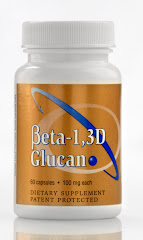Hematopoiesis is the process by which your bone marrow produces stem cells. Stem cells are one of the most vital needs of your immune system, because stem cells ultimately become white blood cells. Specialized types of white blood cells are called phagocytes; these include macrophages, neutrophils, and eosenophils. One function of these phagocytes is to engluf invaders (or any foreign substance) immediately, without question. This process is called phagocytosis.
Phagocytosis has also been tested and shown to be enhanced by Transfer Point's Beta Glucan. The phagocyte's ability to engulf foreign substances is very important. The faster phagocytosis happens, the more debris the phagocyte can destroy. When a phagocyte digests an invader, it notifies the proper authorities (T cells), to let them know there is a foreign substance present. The T cells decide the best action to pursue in order to relieve the body of this foreign substance. Once the phagocyte presents the debris of the invader, the T cells have a couple options.
If the T cell initiates a cell mediated immune response, all phagocytes that have flocked to the site of infection are assisted by other specific white blood cells. This charge of cells is called chemotaxis. Chemotaxis has been tested and shown to be enhanced by Transfer Point's Beta Glucan. When the phagocytes reach the site of invasion, they produce reactive oxygen intermediates (ROIs) and reactive nitrogen intermediates (NOIs). These ROIs and NOIs include hydrogen peroxide (H2O2) and nitric oxide (NO), and are very important in helping the phagocytes to rapidly destroy the invader. Transfer Point's Beta Glucan has been tested and shown to help phagocytes produce more ROIs and NOIs. Therefore, the faster the phagocytes reach the site of invasion, and use ROIs and NOIs, the faster the intruder's position is compromised.
However, if the T cell initiates a humoral immune response, B cells are notified to create plasma cells, which create antibodies to fight the infection. These antibodies are actually chemicals designed to tag a specific invader, and take about 21 days to fully develop. When the antibodies are ready, they are sent out to target the specific substance for which they are made. Until these antibodies are ready, it is up to the innate immunity to directly come in contact, hand to hand combat, and ultimately engulf the intrusive substance.
Innate immunity is what keeps you alive, until acquired immunity is established. In some cases, a person's immune system programs itself to rely too much on a humoral (antibody) response verses a cell mediated immune response. Transfer Point's Beta Glucan has been tested and shown to correct an over-shifted humoral response to a cell mediated immune response. Anecdotal evidence and theory suggest this is helpful in allergies, autoimmune disease, and cancer.
Showing posts with label mediated immune response. Show all posts
Showing posts with label mediated immune response. Show all posts
Sunday, September 6, 2009
Subscribe to:
Posts (Atom)



